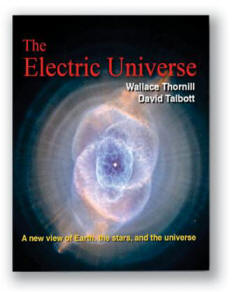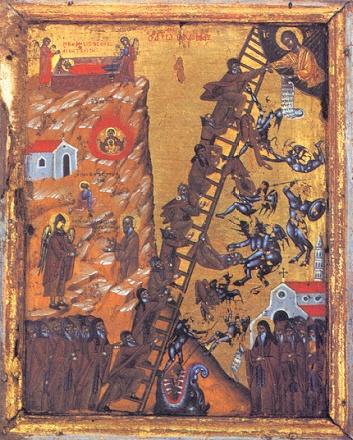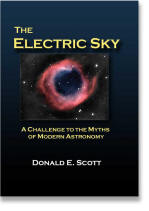
home •
about •
essential guide •
picture of the day •
thunderblogs •
news •
multimedia •
predictions •
products •
get involved •
contact
picture of the day archive subject index
Human souls ascending a ladder on an illustration of St. John Climacus
(† 606 CE), The Ladder of Paradise
Apr 09, 2008
The Spirit of Mythology – Part One
The soul is one of the most complex subjects in the study of religion and mythology, both in terms of its nature and its behaviour.On an empirical level, it is a task for biologists, such as physiologists and neurologists, to determine whether human beings, as well as other forms of life, have a soul, what this soul is made of, how it relates to consciousness, intelligence, memory and personality, and whether it survives the death of the physical body. Yet quite apart from such scientific enquiries into the physical nature of the ‘soul’, traditional human perceptions of the soul and its peregrinations can be studied independently as a branch of philosophy or the history of ideas; in doing so, it quickly transpires that a vast continuum connects some of the crudest mythological beliefs about the soul to the most sophisticated expressions of mysticism in a surprisingly uniform set of “archetypal” motifs.
A helpful distinction separates traditions concerning the “pre-mortal” and the “post-mortal” fates of the soul: while mystical experiences allow living people with a visionary gift a window to the world of the soul, the body of beliefs describing the wandering of disembodied souls after death has been characterised as “funerary mythology”.
Accounts of the “other world” reached after death cannot be verified scientifically, but scientists may illuminate aspects of visionary ‘enlightenment’, for example by demonstrating that particular categories of people are more prone to such experiences, including people suffering from temporal lobe epilepsy, hypersensitive people, people on a rhythmically-induced trance, or people on the verge of death through torture, a traffic accident or other forms of extreme exhaustion.To the comparative mythologist, it becomes quickly apparent that the imaginary landscape through which the discarnate souls of both living and dead people are believed to move tend to have a strong celestial or astral aspect. The popular understanding that the souls of the dead ‘go to heaven’ corresponds to a deeply ingrained and practically universal belief that such souls somehow make their way into the night sky, where they traverse the Milky Way or are turned into stars. For example, the Tiwi people, of Bathurst and Melville Islands in the Northern Territory of Australia, contend that “the spirits of the dead” are carried to “a utopian upper world or tuniruna, blessed with adequate rainfall and abundant food. Some groups imagined it as a land of beautiful flowers that never faded. … and we see them as stars shining through holes in the cover.”
Just as the axis mundi – as a cosmic tree, mountain or pillar connecting the poles – is the pivot of the material world in traditional cosmologies, so it is identified as the principal conduit of souls in countless traditions throughout the world. The Maya of Yucatán, for instance, claim that the souls of the dead ascend a tree by means of a ladder made of vines or climbers.
The Mocoví people, of Paraguay, hold that “the souls of the dead go up ‘to the earth on high’ by the tree which joins us to heaven”. Just so, the Guaraní and the Carib believed that the disembodied soul ascends “the tree of heaven”, planted in a garden, at the top of which it will meet its creator, called Tamoi or Tamu.
Old World counterparts to such beliefs tend to relate to the experience of the ascetic rather than the deceased. Thus, Vedic texts portray the ascent of the spirit to heaven in terms of climbing a tree: “As one would keep climbing up a tree by steps … he keeps ascending these worlds”.
The prophet Mohammed is believed to have passed the sidrat al‑muntahâ, a celestial tree, during his famous ascent through the heavens. The Christian mystic, John of Ruysbroeck († 1381 CE), declared that the mystic “must climb into the tree of belief”, which, undoubtedly, was modelled on the image of the cross of Christ as the tree of life. And within Judaism, enlightened souls enjoyed a “psychonautic” journey along a similar column:
“There is an upper and a lower Paradise. And between them, upright, is fixed a pillar; and by this they are joined together; and ’t is called ‘The Strength of the Hill of Sion’. And by this Pillar on every Sabbath and Festival the righteous climb up and feed themselves with a glance of the Divine majesty till the end of the Sabbath or Festival, when they slide down and return into the lower Paradise.”
Contributed by Rens Van der Sluijs
Further Reading:
The Mythology of the World Axis; Exploring the Role of Plasma in World Mythology
www.lulu.com/content/1085275The World Axis as an Atmospheric Phenomenon
www.lulu.com/content/1305081
___________________________________________________________________________Please visit our Forum
The Electric Sky and The Electric Universe available now!

|
|

|
EXECUTIVE EDITORS:
David Talbott, Wallace Thornhill
MANAGING EDITORS:
Steve Smith, Mel Acheson
CONTRIBUTING EDITORS: Michael Armstrong, Dwardu Cardona,
Ev Cochrane,
C.J. Ransom, Don Scott, Rens van der Sluijs, Ian Tresman
WEBMASTER: Brian Talbott
Copyright 2007: thunderbolts.info
![]()
home •
thunderblogs •
forum •
picture of the day •
resources •
team •
updates •
contact us

